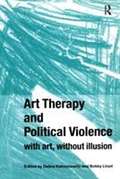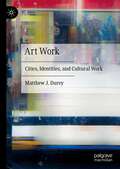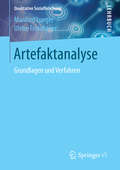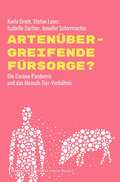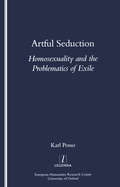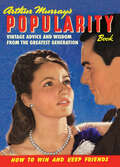- Table View
- List View
Art, Spirituality and Economics: Liber Amicorum for Laszlo Zsolnai (Virtues and Economics #2)
by Luk Bouckaert Knut J. Ims Peter RonaThis volume celebrates the work of Laszlo Zsolnai, a leading researcher and scholar in the field of the ethical and spiritual aspects of economic life, who has made significant contributions to the connection between ethics, spirituality, aesthetics and economic theory. The book offers a selection of essays concerned with the ethical, spiritual and aesthetic context within which economics as a social studies discipline should be situated in order to avoid the sort of dehumanising consequences that theories based on utility maximisation and rational choice necessarily entail. It presents the economic activities of human beings not as some sort of preordained obedience to universal laws that operate independently of other human concerns, but, rather, as a part of the human desire for the Aristotelian good life. It looks at the various considerations –moral, spiritual and aesthetic – that take part in the formation of economic decisions in sharp contrast with theories that purport to explain economic phenomena solely on the basis of utility maximisation.
The Art Therapist’s Guide to Social Media: Connection, Community, and Creativity
by Gretchen M. MillerThe Art Therapist#65533;s Guide to Social Media offers the art therapy community a guide that addresses content related to social media use, its growing influence, and the impact social networking has on the profession and work of art therapists. This book presents a framework of relevant theories, best practices, and examples to explore existing and emerging areas of social networking's power for art therapists as practitioners and artists. Divided into three sections that highlight the themes of connection, community, and creativity, chapters explore timely topics such as the professional use of social media, ethical considerations, potential benefits and challenges, and strategies to embrace the possibilities that social media can create for the field worldwide. Art therapists in training, art therapy educators and supervisors, and practicing art therapists will find content in this text helpful for their learning and professional practice. #65533;
The Art Therapist’s Guide to Social Media: Connection, Community, and Creativity (PDF)
by Gretchen M. MillerThe Art Therapist#65533;s Guide to Social Media offers the art therapy community a guide that addresses content related to social media use, its growing influence, and the impact social networking has on the profession and work of art therapists. This book presents a framework of relevant theories, best practices, and examples to explore existing and emerging areas of social networking's power for art therapists as practitioners and artists. Divided into three sections that highlight the themes of connection, community, and creativity, chapters explore timely topics such as the professional use of social media, ethical considerations, potential benefits and challenges, and strategies to embrace the possibilities that social media can create for the field worldwide. Art therapists in training, art therapy educators and supervisors, and practicing art therapists will find content in this text helpful for their learning and professional practice. #65533;
Art Therapy And Political Violence: With Art, Without Illusion (PDF)
by Bobby Lloyd Debra Kalmanowitz Shaun McNiff Diane WallerThe impact of political violence, war, civil war and acts of terrorism on the individuals involved can be extensive. Art therapy can provide an effective means of expressing the resulting experiences of fear, loss, separation, instability and disruption. Art Therapy and Political Violence brings together contributions from all over the world and from diverse theoretical backgrounds. With contributions from Northern Ireland, Kosovo, Israel and South Africa, the book includes numerous clinical examples to vividly illustrate the main issues affecting art therapy. The practical issues involved are also discussed, including subjects such as the importance of working with both the internal and external worlds of the individual and sensitivity to cultural issues. Art therapists, psychotherapists and other mental health professionals, particularly those working in the context of political violence or in countries of refuge, will find the experiences recounted in Art Therapy and Political Violence thought-provoking and will welcome the wealth of practical information provided.
Art Therapy And Political Violence: With Art, Without Illusion
by Bobby Lloyd Debra Kalmanowitz Shaun McNiff Diane WallerThe impact of political violence, war, civil war and acts of terrorism on the individuals involved can be extensive. Art therapy can provide an effective means of expressing the resulting experiences of fear, loss, separation, instability and disruption. Art Therapy and Political Violence brings together contributions from all over the world and from diverse theoretical backgrounds. With contributions from Northern Ireland, Kosovo, Israel and South Africa, the book includes numerous clinical examples to vividly illustrate the main issues affecting art therapy. The practical issues involved are also discussed, including subjects such as the importance of working with both the internal and external worlds of the individual and sensitivity to cultural issues. Art therapists, psychotherapists and other mental health professionals, particularly those working in the context of political violence or in countries of refuge, will find the experiences recounted in Art Therapy and Political Violence thought-provoking and will welcome the wealth of practical information provided.
Art Therapy with Transgender and Gender-Expansive Children and Teenagers
by Kelly Darke Shannon Scott-MillerAn educational and inspirational book that offers practical guidance for art therapists working with transgender and gender-expansive youth and their families. It provides art therapy goals, recommended treatments and coping skills to use with this client group.Each chapter looks at how art therapy can address a different concern or aspect of the experience, such as transitioning, bullying, and recognizing or building a support system. It includes detailed case studies and cutting-edge art therapy interventions, which help young people to express the emotions surrounding the discovery of gender identity, the transition process, and self-care.
Art, Trade, and Cultural Mediation in Asia, 1600–1950
by Raquel A. G. ReyesThis Palgrave Pivot explores the social and cultural impact of global trade at a micro-level from around 1600 to 1950. Bringing together the collaborative skills of cultural, social, economic, and art historians, it examines how the diffusion of trade, goods and objects affected people’s everyday lives. The authors tell several stories: of the role played by a host of intermediaries – such as apothecaries, artisans and missionaries who facilitated the process; of objects such as Japanese export lacquer-ware and paintings; of how diverse artistic influences came to be expressed in colonial church architecture in the Philippines; of revolutionary changes wrought on quotidian tastes and preferences, as shown in the interior decoration of private homes in the Dutch East Indies; and of transformations in the smoking and drinking habits of Southeast Asians. The chapters consider the conditions from which emerged new forms of artistic production and transfer, fresh cultural interpretations, and expanded markets for goods, objects and images.
Art Work: Cities, Identities, and Cultural Work
by Matthew J. DureyThis book is about the relationship between art and work in the cultural economy. It is an exploration of the experiences of people working in cultural and creative industries, and of the importance of place, identity, and culture in postindustrial society. Drawing on fieldwork exploring the conditions of cultural work, identity, and postindustrial cities in Newcastle upon Tyne, UK and Hamburg, Germany, the book argues that the conditions of work in the cultural economy are the result of a contradictory tension between art and economy, which manifests in various ways in artists’ conditions of work, their identities, and their relationship to the changing landscapes of postindustrial cities. This is explored through a series of stories from people working in cultural and creative industries, in which they highlight significant contradictions, obstacles, and opportunities in negotiating the cultural economy, casting light on the importance of art and culture in postindustrial society.
Art Worlding: Planning Relations (Visual Modernities)
by Julie CrawshawTracing the associations between artists, planners and engineers with and within the materials of our environment, this book introduces the more than human relational theory of ‘art worlding’ as a way of coming to know our relational continuity. Through a series of ‘sculptural’ ethnographies of the making and doing of art in urban and rural contexts, the author re-orientates the art-planning relationship in recognition of art practice as a way of knowing more than human relations, thus promoting the organic continuity between humans and environment. Methodologically innovative, the book traces the inter-relation of art as part of planning practice and integrates artistic practice as a mode of inquiry within planning research. It introduces a new paradigm for public art scholarship and practice that re-connects art and planning. Art Worlding: Planning Relations will appeal to sociologists and social anthropologists with interests in art practice, as well as those working in the fields of urban and rural planning, urban regeneration and cultural management.
Art Worlding: Planning Relations (Visual Modernities)
by Julie CrawshawTracing the associations between artists, planners and engineers with and within the materials of our environment, this book introduces the more than human relational theory of ‘art worlding’ as a way of coming to know our relational continuity. Through a series of ‘sculptural’ ethnographies of the making and doing of art in urban and rural contexts, the author re-orientates the art-planning relationship in recognition of art practice as a way of knowing more than human relations, thus promoting the organic continuity between humans and environment. Methodologically innovative, the book traces the inter-relation of art as part of planning practice and integrates artistic practice as a mode of inquiry within planning research. It introduces a new paradigm for public art scholarship and practice that re-connects art and planning. Art Worlding: Planning Relations will appeal to sociologists and social anthropologists with interests in art practice, as well as those working in the fields of urban and rural planning, urban regeneration and cultural management.
The Artefacts of Digital Mental Health (Health, Technology and Society)
by Jacinthe FloreThe Artefacts of Digital Mental Health focuses on smartphone apps, wearables devices, and ingestible sensors, which are at the centre of research, development, and investment in mental health and digitalisation. The book aims to examine digital mental health through three artefacts that are defined by their ubiquity, everydayness, popularity, innovation and hype, and emergent qualities. It engages with theoretical approaches to technology, mental health, and wellbeing informed by Science and Technology Studies, sociological studies of health and mental health, and sociomaterialism. The book brings together different theories of mental health, subjectivity, the body, care, and digitalisation alongside biodigital artefacts as exemplars of transformations in digital mental health.
Artefaktanalyse: Grundlagen und Verfahren (Qualitative Sozialforschung)
by Manfred Lueger Ulrike FroschauerDer vorliegende Band zeigt, wie man Artefakte systematisch analysieren und ihr Erkenntnispotential für ein tieferes Verständnis von Gesellschaft nutzen kann. Im Zentrum stehen die Grundfragen der Artefaktanalyse, nämlich warum und wie Gegenstände von wem und mit welchen Folgen für die Menschen und ihr Zusammenleben hergestellt wurden. Für die Sozialwissenschaften erschließt diese Methode ein in unserer Gesellschaft omnipräsentes Material und untersucht es in seiner Bedeutung für alltägliche Handlungsweisen sowie für die Konstitution unserer Umwelt.
Artemisia Gentileschi and the Business of Art
by Christopher R. MarshallA new account of the renowned Baroque painter, revealing how her astute professional decisions shaped her career, style, and legacyArt has long been viewed as a calling—a quasi-religious vocation that drives artists to seek answers to humanity&’s deepest questions. Yet the art world is a risky, competitive business that requires artists to make strategic decisions, especially if the artist is a woman. In Artemisia Gentileschi and the Business of Art, Christopher Marshall presents a new account of the life, work, and legacy of the Italian Baroque painter, revealing how she built a successful four-decade career in a male-dominated field—and how her business acumen has even influenced the resurrection of her reputation today, when she has been transformed from a footnote of art history to a globally famous artist and feminist icon.Combining the most recent research with detailed analyses of newly attributed paintings, the book highlights the business considerations behind Gentileschi&’s development of a trademark style as she marketed herself to the public across a range of Italian artistic centers. The disguised self-portraits in her early Florentine paintings are reevaluated as an effort to make a celebrity brand of her own image. And, challenging the common perception that Gentileschi&’s only masterpieces are her early Caravaggesque paintings, the book emphasizes the importance of her neglected late Neapolitan works, which are reinterpreted as innovative responses to the conventional practices of Baroque workshops.Artemisia Gentileschi and the Business of Art shows that Gentileschi&’s remarkable success as a painter was due not only to her enormous talent but also to her ability to respond creatively to the continuously evolving trends and challenges of the Italian Baroque art world.
Artemisia Gentileschi and the Business of Art
by Christopher R. MarshallA new account of the renowned Baroque painter, revealing how her astute professional decisions shaped her career, style, and legacyArt has long been viewed as a calling—a quasi-religious vocation that drives artists to seek answers to humanity&’s deepest questions. Yet the art world is a risky, competitive business that requires artists to make strategic decisions, especially if the artist is a woman. In Artemisia Gentileschi and the Business of Art, Christopher Marshall presents a new account of the life, work, and legacy of the Italian Baroque painter, revealing how she built a successful four-decade career in a male-dominated field—and how her business acumen has even influenced the resurrection of her reputation today, when she has been transformed from a footnote of art history to a globally famous artist and feminist icon.Combining the most recent research with detailed analyses of newly attributed paintings, the book highlights the business considerations behind Gentileschi&’s development of a trademark style as she marketed herself to the public across a range of Italian artistic centers. The disguised self-portraits in her early Florentine paintings are reevaluated as an effort to make a celebrity brand of her own image. And, challenging the common perception that Gentileschi&’s only masterpieces are her early Caravaggesque paintings, the book emphasizes the importance of her neglected late Neapolitan works, which are reinterpreted as innovative responses to the conventional practices of Baroque workshops.Artemisia Gentileschi and the Business of Art shows that Gentileschi&’s remarkable success as a painter was due not only to her enormous talent but also to her ability to respond creatively to the continuously evolving trends and challenges of the Italian Baroque art world.
Artenübergreifende Fürsorge?: Die Corona-Pandemie und das Mensch-Tier-Verhältnis (Human-Animal Studies #30)
by Karla Groth Stefan Laser Isabelle Sarther Jennifer SchirrmacherMenschen und Tiere infizieren sich, Keulungen scheinen alternativlos und industrielle Routinen brechen zusammen: Die Corona-Pandemie hat die skandalösen Arbeitsstrukturen und globalen Verzahnungen im Kontext von Tierhaltung und Lebensmittelindustrie sichtbar gemacht. Die Autor*innen gehen den öffentlichen Diskursen und den bisher gezogenen Konsequenzen dieses Themenfeldes nach. Sie untersuchen ausgewählte journalistische sowie soziale Medien und zeigen anhand der Kontroversen um Schwein und Nerz die Verwobenheit menschlicher und nichtmenschlicher Spezies auf. Dabei wird klar, dass die Zukunft des Planeten davon abhängt, dass eine artenübergreifende Fürsorge gepflegt werden muss.
Artful Collaborative Inquiry: Making and Writing Creative, Qualitative Research
by Davina Kirkpatrick Sue Porter Jane Speedy Jonathan WyattArtful Collaborative Inquiry comprises essays created collectively by a group of scholars and artists, the majority of whom have several decades of experience of working together. The book challenges commonly-held, individualistic beliefs about ownership, authorship and scholarly and artistic ethics and practices. The essays exemplify the entangled kinds of scholarly and artistic works that emerge in a post-human world, where humans, other species, environments, things and other matters, all matter and are of equal concern in the conduct of ethical artful scholarship. Situated at the (messy) crossroads where contemporary scholarship and artistic practice converge, the seamless mo(ve)ment and interplay between text and image make up the main body of the work in this book. The chapters combine the playful use and merging of time, space and place, researcher and researched, to give a unique exemplar of research and creativity in the rapidly emerging field of collaborative scholarship. It will be of particular interest to creative and qualitative scholars wishing to conduct more artful research, and artists engaging with scholarship.
Artful Design: Technology in Search of the Sublime, A MusiComic Manifesto
by Ge WangWhat we make, makes us. This is the central tenet of Artful Design, a photorealistic comic book that examines the nature, purpose, and meaning of design. A call to action and a meditation on art, authenticity, and social connection in a world disrupted by technological change, this book articulates a fundamental principle for design: that we should design not just from practical needs but from the values that underlie those needs. Artful Design takes readers on a journey through the aesthetic dimensions of technology. Using music as a universal phenomenon that has evolved alongside technology, this book breaks down concrete case studies in computer-mediated toys, tools, games, and instruments, including the best-selling app Ocarina. Every chapter elaborates a set of general design principles and strategies that illuminate the essential relationship between aesthetics and engineering, art and design. Ge Wang implores us to both embrace and confront technology, not purely as a means to an end, but in its potential to enrich life. Technology is never a neutral agent, but through what we do with it—through what we design with it—it provides a mirror to our human endeavors and values. Artful Design delivers an aesthetic manifesto of technology, accessible yet uncompromising.
The Artful Economist: A New Look at Cultural Economics
by Ilde Rizzo Ruth TowseThis book reassesses central topics in cultural economics: Public finance and public choice theory as the basis for decision-making in cultural and media policy, the role of welfare economics in cultural policy, the economics of creative industries, the application of empirical testing to the performing arts and the economics of cultural heritage. Cultural economics has made enormous progress over the last 50 years, to which Alan Peacock made an important contribution. The volume brings together many of the senior figures, whose contributions to the various special fields of cultural economics have been instrumental in the development of the subject, and others reflecting on the subject's progress and assessing its future direction. Alan Peacock has been one of the leading lights of cultural economics and in this volume Ilde Rizzo and Ruth Towse and the other contributors ably capture the import of his contributions in a broader context of political economy. In doing so, they offer an overview of progress in cultural economics over the last forty years.Tyler Cowen, Professor of Economics and Director of the Mecatus Center, George Mason University, Fairfax, Virginia, USA A fitting tribute to Professor Sir Alan Peacock's inspiring intellect leadership and his outstandingly rich and varied legacy in the domain of cultural economics, this book draws together illuminating analyses and insights from leading cultural economists about the role and value of this dynamic and increasingly policy-relevant field of enquiry. Gillian Doyle, Professor of Media Economics and Director of Centre for Cultural Policy Research, University of Glasgow, UK
Artful Seduction: Homosexuality and the Problematics of Exile
by Karl Posso"The controversial works of Brazilian authors Silviano Santiago(1936-) and Caio Fernando Abreu (1948-96) offer distinctive but complementary explorations of male homosexual subjectivities formulated through displacement, exile and the abject. Posso examines the innovative ways in which these writers stage-manage Western poststructuralist thought to critique heterosexist exclusion in Brazil and in globalized popular and folk culture, and he explains how they draw on diverse cultural productions and art works to extend a general undermining of oppositional logic and psychoanalytic theory."
Artful Seduction: Homosexuality and the Problematics of Exile
by Karl Posso"The controversial works of Brazilian authors Silviano Santiago(1936-) and Caio Fernando Abreu (1948-96) offer distinctive but complementary explorations of male homosexual subjectivities formulated through displacement, exile and the abject. Posso examines the innovative ways in which these writers stage-manage Western poststructuralist thought to critique heterosexist exclusion in Brazil and in globalized popular and folk culture, and he explains how they draw on diverse cultural productions and art works to extend a general undermining of oppositional logic and psychoanalytic theory."
Arthur Ashe: Tennis and Justice in the Civil Rights Era
by Eric Allen HallArthur Ashe explains how this iconic African American tennis player overcame racial and class barriers to reach the top of the tennis world in the 1960s and 1970s. But more important, it follows Ashe’s evolution as an activist who had to contend with the shift from civil rights to Black Power. Off the court, and in the arena of international politics, Ashe positioned himself at the center of the black freedom movement, negotiating the poles of black nationalism and assimilation into white society. Fiercely independent and protective of his public image, he navigated the thin line between conservatives and liberals, reactionaries and radicals, the sports establishment and the black cause.Eric Allen Hall’s work examines Ashe’s life as a struggle against adversity but also a negotiation between the comforts—perhaps requirements—of tennis-star status and the felt obligation to protest the discriminatory barriers the white world constructed to keep black people "in their place."Drawing on coverage of Ashe’s athletic career and social activism in domestic and international publications, archives including the Ashe Papers, and a variety of published memoirs and interviews, Hall has created an intimate, nuanced portrait of a great athlete who stood at the crossroads of sports and equal justice.
Arthur Ashe: Tennis and Justice in the Civil Rights Era
by Eric Allen HallArthur Ashe explains how this iconic African American tennis player overcame racial and class barriers to reach the top of the tennis world in the 1960s and 1970s. But more important, it follows Ashe;€™s evolution as an activist who had to contend with the shift from civil rights to Black Power. Off the court, and in the arena of international politics, Ashe positioned himself at the center of the black freedom movement, negotiating the poles of black nationalism and assimilation into white society. Fiercely independent and protective of his public image, he navigated the thin line between conservatives and liberals, reactionaries and radicals, the sports establishment and the black cause.Eric Allen Hall;€™s work examines Ashe;€™s life as a struggle against adversity but also a negotiation between the comforts;¢;‚¬;€?perhaps requirements;¢;‚¬;€?of tennis-star status and the felt obligation to protest the discriminatory barriers the white world constructed to keep black people "in their place."Drawing on coverage of Ashe;€™s athletic career and social activism in domestic and international publications, archives including the Ashe Papers, and a variety of published memoirs and interviews, Hall has created an intimate, nuanced portrait of a great athlete who stood at the crossroads of sports and equal justice.
Arthur Murray’s Popularity Book: Vintage Advice and Wisdom from The Greatest Generation
by Arthur MurrayFIRST PUBLISHED IN 1944, the Popularity Book is a vintage guidebook full of wise and wonderful advice on living well, building poise and maintaining good relationships. Drawing on books, testimonials and magazines from the World War II era, it shows the forthright common sense and charming romanticism of the "Greatest Generation†?, a generation inspired by debonair role models such as Clark Gable, Cary Grant and Katharine Hepburn. As relevant today as it was in the 1940s, the Popularity Book offers counsel on being an unforgettably great date, eliciting a marriage proposal, and how to be generally charming. Compiled and originally published by Arthur Murray, it also features his iconic step-by-step footprint instructions on how to Samba, Fox Trot and Rumba divinely!
Arthur Murray’s Popularity Book: Vintage Advice and Wisdom from The Greatest Generation (Old House Ser.)
by Arthur MurrayFIRST PUBLISHED IN 1944, the Popularity Book is a vintage guidebook full of wise and wonderful advice on living well, building poise and maintaining good relationships. Drawing on books, testimonials and magazines from the World War II era, it shows the forthright common sense and charming romanticism of the “Greatest Generation”, a generation inspired by debonair role models such as Clark Gable, Cary Grant and Katharine Hepburn. As relevant today as it was in the 1940s, the Popularity Book offers counsel on being an unforgettably great date, eliciting a marriage proposal, and how to be generally charming. Compiled and originally published by Arthur Murray, it also features his iconic step-by-step footprint instructions on how to Samba, Fox Trot and Rumba divinely!
Arthur Sullivan: A Victorian Musician (Routledge Revivals)
by Arthur JacobsPublished in 1992. This is a revised, enlarged edition of a book which on its original appearance in 1984 was hailed as a landmark in the study of Victorian musical life. It presents the figure of Sir Arthur Sullivan (1842-1990) not only as the celebrated co-creator of light operas with W.S Gilbert, but as a composer of all kinds of music from symphony and concerto to ballads such as ‘The Lost Chord’ and hymns such as ‘Onward, Christian Soldiers’. A prominent public life, with a knighthood in 1883, is contrasted with an unconventional private life involving a liaison of almost thirty years with an American living in London, Mary Frances Ronalds. The author’s access to Sullivan’s diary held by Yale University and to letters and other documents at the Pierpont Morgan library in New York gives this book both a unique authority and a deep human understanding. A new chapter updates research to the 150th anniversary of the composer’s birth, 1992, and incorporates music examples.


